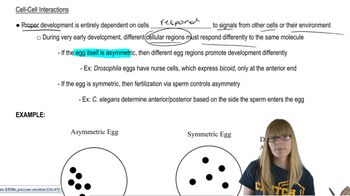Using the components in the accompanying diagram, design regulatory modules (i.e., enhancer/silencer modules) required for 'your' gene to be expressed only in differentiating (early) and differentiated (late) liver cells. Answer the three questions presented below by describing the roles that activators, enhancers, repressors, silencers, pioneer factors, insulators, chromatin remodeling complexes, and chromatin readers, writers, and erasers will play in the regulation of expression of your gene, that is, what factors will bind and be active in each case? Specify which transcription factors need to be pioneer factors. How will the gene be activated in the proper cell type?
Table of contents
- 1. Introduction to Genetics51m
- 2. Mendel's Laws of Inheritance3h 37m
- 3. Extensions to Mendelian Inheritance2h 41m
- 4. Genetic Mapping and Linkage2h 28m
- 5. Genetics of Bacteria and Viruses1h 21m
- 6. Chromosomal Variation1h 48m
- 7. DNA and Chromosome Structure56m
- 8. DNA Replication1h 10m
- 9. Mitosis and Meiosis1h 34m
- 10. Transcription1h 0m
- 11. Translation58m
- 12. Gene Regulation in Prokaryotes1h 19m
- 13. Gene Regulation in Eukaryotes44m
- 14. Genetic Control of Development44m
- 15. Genomes and Genomics1h 50m
- 16. Transposable Elements47m
- 17. Mutation, Repair, and Recombination1h 6m
- 18. Molecular Genetic Tools19m
- 19. Cancer Genetics29m
- 20. Quantitative Genetics1h 26m
- 21. Population Genetics50m
- 22. Evolutionary Genetics29m
13. Gene Regulation in Eukaryotes
Overview of Eukaryotic Gene Regulation
Problem 23a
Textbook Question
Much of what we know about gene interactions in development has been learned using nematodes, yeast, flies, and bacteria. This is due, in part, to the relative ease of genetic manipulation of these well-characterized genomes. However, of great interest are gene interactions involving complex diseases in humans. Wang and White [(2011). Nature Methods 8(4):341–346] describe work using RNAi to examine the interactive proteome in mammalian cells. They mention that knockdown inefficiencies and off-target effects of introduced RNAi species are areas that need particular improvement if the methodology is to be fruitful.
How might one use RNAi to study developmental pathways?
 Verified step by step guidance
Verified step by step guidance1
Understand that RNA interference (RNAi) is a technique used to reduce or 'knock down' the expression of specific genes by targeting their messenger RNA (mRNA) for degradation, thereby preventing protein production.
Identify the gene or genes of interest involved in a developmental pathway that you want to study, focusing on those suspected to play key roles in development.
Design or obtain RNAi molecules (such as small interfering RNAs, siRNAs) that specifically target the mRNA transcripts of these genes to reduce their expression in the cells or organism under study.
Introduce the RNAi molecules into the cells or model organism at appropriate developmental stages, then observe and analyze the resulting phenotypic changes or disruptions in the developmental process to infer gene function and interactions.
Control for potential off-target effects and incomplete knockdown by including proper experimental controls and possibly using multiple RNAi sequences targeting the same gene to validate the observed effects.
 Verified video answer for a similar problem:
Verified video answer for a similar problem:This video solution was recommended by our tutors as helpful for the problem above
Video duration:
2mPlay a video:
Was this helpful?
Key Concepts
Here are the essential concepts you must grasp in order to answer the question correctly.
RNA Interference (RNAi) Mechanism
RNAi is a biological process where small RNA molecules inhibit gene expression by degrading specific mRNA transcripts. This targeted knockdown allows researchers to reduce or silence the expression of particular genes, making it a powerful tool to study gene function in developmental pathways.
Recommended video:
Guided course

RNA Interference
Gene Interactions in Developmental Pathways
Developmental pathways involve networks of genes that regulate cell differentiation and organismal growth. Understanding how genes interact helps reveal the roles of individual genes and their combined effects, which can be studied by selectively silencing genes using RNAi to observe resulting phenotypic changes.
Recommended video:
Guided course

Interacting Genes Overview
Challenges of RNAi in Mammalian Cells
RNAi in mammalian cells faces challenges such as incomplete gene knockdown and off-target effects, where unintended genes are silenced. These issues can complicate data interpretation, so improving RNAi specificity and efficiency is crucial for accurately studying gene functions in complex developmental pathways.
Recommended video:
Guided course

Cell-cell interactions
Related Videos
Related Practice
Textbook Question
465
views


